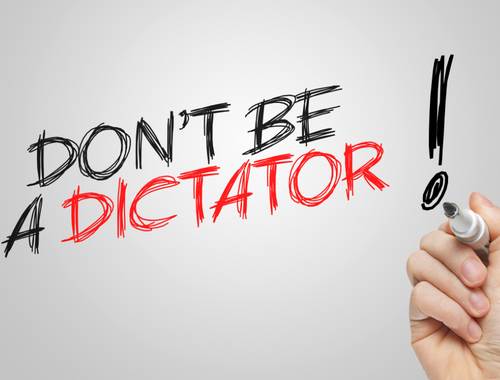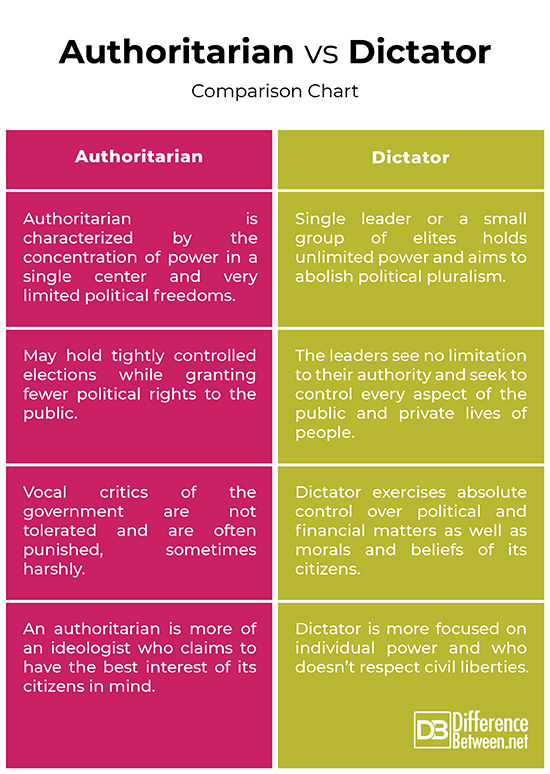Difference Between Authoritarian and Dictator
Throughout much of human history dictators and autocrats have ruled people’s affairs, if not most empires, nations, states, and societies. In fact, dictatorship has been a defining characteristic of the new global orders. Even today, some parts of the world live under dictatorship, yet we know very little about dictators. We generally assume that all dictators and dictatorships are the same, but that’s not the case. We break down some key differences between the two forms of government – authoritarian and dictatorship.

What is Authoritarian?
Authoritarian government refers to the form of government that is characterized by the concentration of power in a single center, be it a single dictator that governs them all or a group of leaders that hold the power. Authoritarian states do no not care about how foreign audiences view them, and they make intentional and strategic efforts to improve how they are perceived outside their home territory. Authoritarian regimes have greater control over the public and private lives of their people. They maintain their power through repression, co-optation, and legitimation. Vocal critics of the government are not tolerated and are often punished, sometimes harshly. The leader or group of leaders exercises unlimited power.

What is Dictatorship?
Nazi Germany under Adolf Hitler is one of the best examples of modern totalitarian dictatorship. Hitler became absolute dictator of Germany under the title of Fuhrer, after the death of German President Paul von Hindenburg. He was one of the ruthless dictators in the modern human history, who developed the ideas of fascism and turned an armed group into a Fascist army. Most of the threats to dictators actually come from within the regime. So, dictatorship can be described as the violent overthrow of democracy – something like the Chilean coup of Sept. 11, 1973, in which military forces led by Augusto Pinochet overthrew elected President Salvador Allende.
Difference between Authoritarian and Dictator
Governance
– Authoritarian government refers to the form of government that is characterized by the concentration of power in a single center and very limited political freedoms. The government encourages all forms of changes to strengthen democratic political institutions. It is a system of government customarily linked with dictatorship. Dictatorship is a type of authoritarian governance but in a much worse way. It is a form of government where a single leader or a small group of elites holds unlimited power and aims to abolish political pluralism. They not only control the nation but the people as well.
Participation
– Authoritarianism is marked by submission to authority and characterized by the rejection of political plurality. Authoritarian leaders do not anticipate, let alone encourage public participation and may hold tightly controlled elections while granting fewer political rights to the public. Leaders make decisions with no little or no participation or input from their followers or member of the team. Dictatorship, on the other hand, is totalitarian leadership characterized by suppression of political opponents, suspension of elections, and no public participation. The leaders see no limitation to their authority and seek to control every aspect of the public and private lives of people. Public participation is considered public rebellion.
Liberties
– Fundamental liberties is what sets a government apart from other forms of government. Dictators are like authoritarian leaders but seek power and control beyond government rule, and begin to force their ideology on everyone with no regards to the fundamental liberties and rights of their citizens. A dictator is more focused on individual power and who doesn’t respect civil liberties such as freedom of religion, whereas an authoritarian is more of an ideologist who claims to have the best interest of its citizens in mind.
Authoritarian vs. Dictator: Comparison Chart

Summary
In a nutshell, authoritarianism is marked by submission to authority and characterized by the rejection of political plurality whereas dictatorship is totalitarian leadership characterized by suppression of political opponents and suspension of elections. To put in perspective, a dictator is more focused on individual power and who doesn’t respect civil liberties such as freedom of religion, whereas an authoritarian is more of an ideologist who claims to have the best interest of its citizens in mind.
What do you mean by authoritarian government or dictatorship?
An authoritarian is more of an ideologist who claims to have the best interest of its citizens in mind. A dictator is a political leader who holds unlimited power and aims to abolish political pluralism.
What’s the difference between autocratic and dictatorial?
Autocratic is complete authoritarian control over a group with no regards to fundamental rights and civil liberties of people, similar to dictatorship. They tend to create highly structured and rigid environments.
What’s the difference between authoritarian and totalitarian?
Authoritarian leaders make decisions with little or no participation or input from their followers or member of the team but claim to have the best interest of its citizens in mind. Totalitarian is characterized the concentration of power in a single center.
What does authoritarian mean?
Authoritarian states do not tolerate parties of differing opinions and exercise dictatorial control over many aspects of life.
Who is an example of an authoritarian leader?
Examples of leaders who are considered authoritarian leaders are Benito Mussolini, Larry Ellison, Vladmir Putin, and Lorne Michaels.
What is an example of dictatorship?
Nazi Germany under Adolf Hitler is one of the best examples of modern totalitarian dictatorship.
- Difference Between Caucus and Primary - June 18, 2024
- Difference Between PPO and POS - May 30, 2024
- Difference Between RFID and NFC - May 28, 2024
Search DifferenceBetween.net :
Leave a Response
References :
[0]Dukalskis, Alexander. Making the World Safe for Dictatorship. Oxford, United Kingdom: Oxford University Press, 2021. Print
[1]Geddes, Barbara, et al. How Dictatorships Work: Power, Personalization, and Collapse. Cambridge, United Kingdom: Cambridge University Press, 2018. Print
[2]Larres, Klaus. Dictators and Autocrats: Securing Power across Global Politics. Oxfordshire, England: Routledge, 2021. Print
